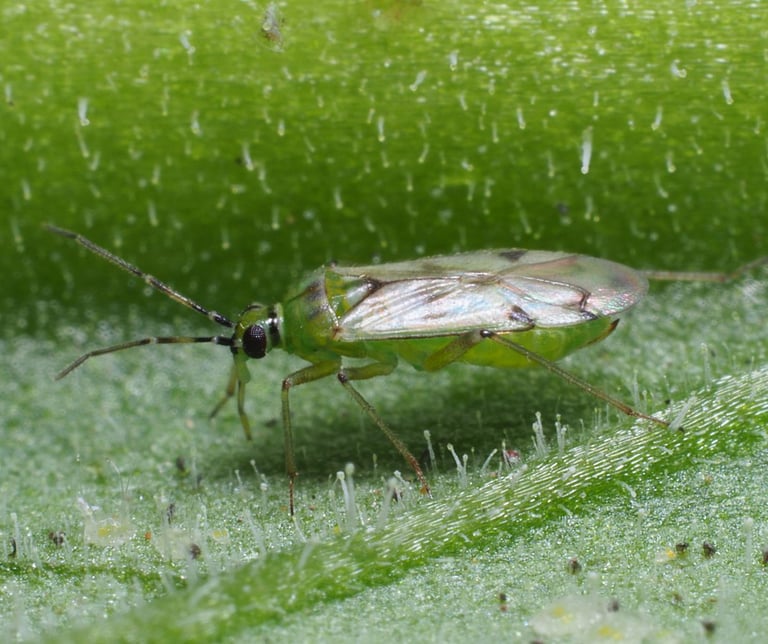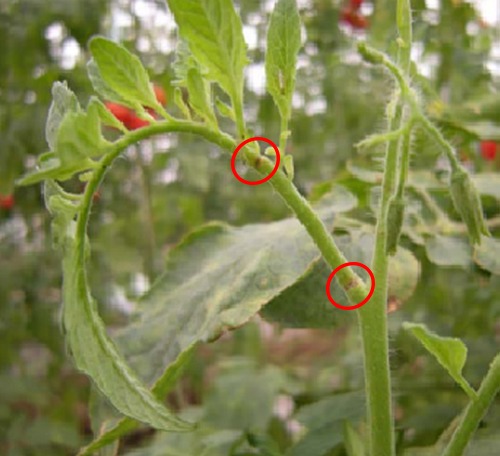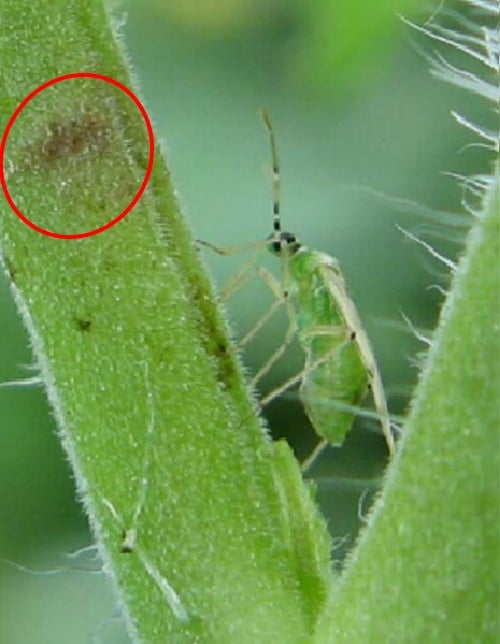Tomato Bug, Nesidiocoris tenuis(Reuter) (Heteroptera: Miridae): A friend turned to foe, Controversial biocontrol agent in tomato crops
Nesidiocoris tenuis is a tropical mirid bug used as a biocontrol agent in protected crops, including tomatoes. Although N. tenuis predates important insect pests, especially whitefly, it also causes damage by feeding on tomato plants when prey populations decline, resulting in significant economic losses for growers. The pest is now established in some all-year-round tomato crops in Europe and control measures involve the application of pesticides which are incompatible with current IPM programs.
Nesidiocoris tenuis (Reuter) (Heteroptera: Miridae) is an omnivorous mirid bug of tropical origin which is used as a biological control agent for protected crops in Mediterranean countries (Biondi et al. 2016; Pérez-Hedo et al. 2021). N. tenuis has been called green tobacco capsid, tobacco leaf bug, tomato mirid, and tomato suck bug. The bug predates a range of economically important crop pests such as whiteflies (family Aleyrodidae), aphids (superfamily Aphidoidea), thrips (order Thysanoptera), and moths (order Lepidoptera) (Kim et al. 2016). However, the use of N. tenuis as a biological control agent is controversial. Although this bug prefers prey, it can start feeding on the crop when prey is absent (Nakaishi et al. 2011; Pérez-Hedo and Urbaneja 2016; Sanchez 2008). Insertion of the stylet into the phloem to derive nutrients leads to brown necrotic rings around stems and petioles followed by the drying of flower stalks and flower abortion (Arnó et al. 2010; Calvo et al. 2009; Castañé et al. 2011; Raman and Sanjayan 1984).
Nesidiocoris tenuis has spread widely into new geographic areas since its original description in the Canary Islands, the Philippines, and several countries in the Middle East, where this species is considered exotic. Currently, N. tenuis has been recorded worldwide except in some countries in South America, Northern Europe, and Russia. The colonization of the new areas by N. tenuis may be due to changes in environmental conditions favourable to its establishment to intentional introductions (N. tenuis is commercially available in Europe and Australia), or unintentional transporting in international commerce. (Gabriela Esparza-Diaz , Thiago Marconi , Carlos A. Avila and Raul T. Villanueva 2021)
Nesidiocoris tenuis has been recorded as a pest of various field and glasshouse crops in Asia and Europe. N. tenuis is also a serious pest of bottle gourd (Lagenaria siceraria L), tomato (Solanum lycopersicum), eggplant (Solanum melongena), potato (Solanum tuberosum), tobacco (Nicotiana tabacum), sesame (Sesamum indicum) and cucrbits (Cucurbitaceae) in India. In France, N. tenuis was first found on tomatoes under glass house in 1986. In some northern European countries N. tenuis has become invasive in glasshouses and the pest is threatening the tomatoes grown in the glasshouses. (Jacobson 2019). In circumstances where N. tenuis needs controlling, traditional control options might not be suitable. Although the bug cannot complete development to adulthood if feeding exclusively on tomato plants (Urbaneja et al. 2005), growers may resort to the use of chemical plant protection products (PPPs), incompatible with IPM programs, to prevent further crop damage. This can lead to a resurgence of whitefly populations and associated viruses, and disruption of other biocontrol systems such as use of predatory mites against spider mites. Moreover, a number of PPP’s have been shown to have lethal and sublethal effects on pollinators (Cloyd 2012; Feltham et al. 2014), and it is recommended that their use is avoided unless absolutely necessary (PAN Europe 2013).
We have indigenously identified semiochemicals that could provide tools for IPM-compatible management of N. tenuis. These semiochemicals could also be used for control of N. tenuis by mass trapping or mating disruption and hence reduce or avoid the use of conventional synthetic pesticides against this pest on protected crops.
Novel IPM Control Program:
Looking at incompatibility of synthetic insecticide with IPM programs, a sustainable containment strategy based on integrated pest management is recommended. During open field trials in bottle gourd, sesame, and tomato; The combination eBionic® FlyStar plus our indigenously identified semiochemical ATT20-NES-TEN have shown quite promising results. This integrated approach brought down the population of Nesidiocoris tenuis well below economic threshold level (ETL).















